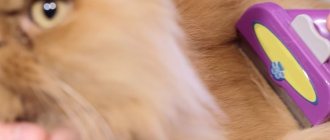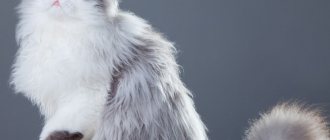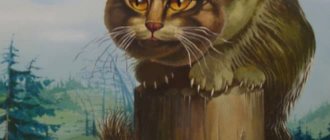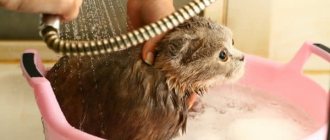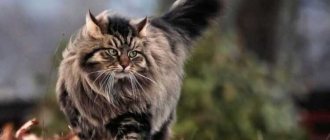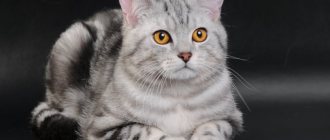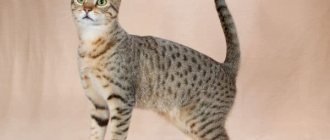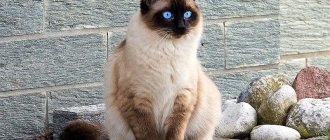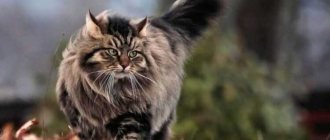The British are the aristocrats of the cat world. Looking at them brings incredible aesthetic pleasure. If you desperately want a cat that will add comfort and warmth to your home, but are afraid that you won't have enough time for a pet, the British is the right breed.
British cream cat
Beautiful, or better yet, luxurious, independent and charming animals with a calm disposition. What's the catch? It would be a lie to say that there is none. Before purchasing a plush kitten, it is better to learn in more detail some points about the character of the British. Then, if you decide that such a pet is ideal for your temperament, do some research on hereditary diseases in the British.
The British cat breed is exactly the option when the miser pays twice. Advertising sites are full of inexpensive kittens. On the other hand, the price for a kitten from a nursery can reach 15-50 thousand rubles. Where does such a range of prices come from and is there any point in overpaying? You need to figure this out on your own. After all, breeders of any price category have their own selfish interest - to sell kittens, so all their words and statements must be considered from a critical point of view.
Author of the article: Olga Shiltsova, practicing veterinarian, author of the books “Dachshund of Fate” and “Tails of Fortune”
General description of the breed
Just look at the “British” and “powerful cat” comes to mind.
This squat and large animal has a large chest and well-developed muscles. Representatives of this breed have a well-balanced body and strong limbs. The British cat is slightly smaller than male cats in all respects. On average, representatives of this breed weigh 5-6 kilograms, and some male British cats can reach 12 kilograms. Such a significant weight requires appropriate powerful paws that could easily move this “colossus.” The British have short and strong legs. They have a thick and fleshy tail, with a slight curve at the end.
British cats have very thick and short hair. The appearance creates an image of balance and harmony; the correct proportions of the body have no deviations. The colors of these animal cats are quite varied, but the most characteristic representatives of this breed are blue and lilac colors.
The British cat can be easily recognized by its massive round head with thick cheeks.
British cats can be easily recognized by their massive round head with characteristic “thick” cheeks. They give the head even greater roundness and massiveness. A small nose and short ears make the British dog's face touching and kind. The British cat has characteristically pronounced jowls (lips), which give its image additional charm.
Tail
It should be short, thick, tapering to a rounded tip, sort of like a log. But, often, the tail is too long for a given breed, and thin and not well dressed, or noticeably tapering towards the tip.
| tail of correct shape and length | the tail is too long, noticeably tapering towards the tip |
How to care for a British cat
Caring for a British cat is not difficult.
Hygiene
The British Shorthair cat takes excellent care of itself and therefore does not require regular hygiene procedures.
The breed is unpretentious in this regard and does not require regular hygiene procedures. Cats take excellent care of themselves: the short length of their fur allows for thorough licking.
To prevent your animal's stomach from becoming clogged with hairballs, you need to brush your cat regularly (at least once a week). There are special dry foods that help remove hair from the digestive tract.
When a cat sheds, brushing should be done even more often, since the shedding is usually quite intense. It is not advisable for cats participating in exhibitions to stay in the open sun for a long time: their fur may acquire a reddish tint at the tips.
The British are very clean. If you accustom them to the tray in time, they will always calmly find it and use it for its intended purpose.
A British cat can only be bathed if it is very dirty or after the animal’s body has been treated for parasites. It is advisable to clean the ears 2 times a month. If the cat is healthy, the sulfur is light and odorless.
What to feed British cats
For the British it is better to choose wide bowls
Cats of this breed love to eat. It is necessary to monitor their weight. Physical activity (games) and restrictive diets will help avoid obesity. British cats are prone to constipation, so you can add a little Vaseline oil (2 ml per day) to their diet.
Representatives of the breed are unpretentious in food and eat a variety of foods. You can feed your cats ready-made food, as it contains all the necessary vitamins, microelements and balanced nutrients. It must be remembered that milk can be given until the age of 3 months. For adult animals, it is replaced with fermented milk products: kefir, sour cream, yogurt.
To make it convenient for cats with large heads to eat, you need to choose wide bowls.
We have a separate article on our website on what to feed a British cat, we recommend that you read it.
Claw cutter
Trimming claws is problematic because they have a specific structure. It is better to allocate space for a post for sharpening the claws. You can come up with it from utility items or buy a ready-made scratching post.
Features of nutrition and pet care
British Shorthairs are unpretentious, caring for them is simple and does not require much time and effort.
Nutrition
Proper nutrition has a major impact on your pet's health. What to feed a representative of the British Shorthair breed? There is no universal answer. Here are some nuances that must be observed:
- the daily portion should not exceed 300 g;
- food should be as fresh as possible and at room temperature;
- The diet should contain plant foods, but since animals eat it reluctantly, finely chopped vegetables should be mixed with meat;
- the preferred types of meat for consumption are: offal, beef, poultry, which must first be frozen - kept in the freezer for at least 2 days;
- eggs - raw or boiled should be given no more than once a week;
Cats can be given boiled and raw eggs once a week.
- You can give fermented milk products, but not often;
- potatoes and cereals should make up a quarter of the diet;
- an adult should eat at least twice a day, a kitten - 4-5 times;
- Your pet should always have water in a bowl;
- if the animal prefers dry food, then it must be of the highest quality.
The British diet can be represented by ready-made food, as well as natural products
Contraindicated for use:
- fatty meat dishes;
- dishes with seasonings;
- smoked meats;
- milk;
- sea fish;
- bird with bones.
Representatives of the breed are prone to obesity, so adhering to the principles of proper nutrition is very important. You should especially carefully monitor the weight of the animal after castration.
Care
The unusually attractive and pleasant-to-touch fur is the main advantage of the British, so its care must be careful and competent. Using a soft brush, you need to comb out the animal's fur weekly. During the molting period, when the process of changing vegetation will be especially active, you will have to arm yourself with a brush every day.
Short-haired cats need to be bathed twice a year or when soiled. Even if you have a scratching post, it is important to trim the claws of an adult animal twice a month to approximately half the total length.
Nails need to be trimmed twice a month
The British eyes need daily cleaning. This must be done carefully, using a cotton pad. Ears should be inspected once every two weeks. The resulting dirt should be removed using a moistened cotton pad or swab.
Tartar formation can be prevented by including roughage in the animal’s diet. Dry food is ideal for this purpose.
Due to the fact that a neat pussy constantly licks its skin, its stomach can become clogged with hairs. To prevent this, the animal should be given special drugs or food that have a resolving effect.
Walk
Walking cats during the day is especially beneficial - sunlight replenishes the lack of vitamin D. Purebred pets should not be allowed outside unattended. Ideally, a “British dog’s” walk should take place in a fenced area - free access to the street, especially in urban areas, threatens the pet with various troubles - collisions with transport, fights with street cats, from which he can become infected with infections, and also bring fleas into the house.
It is better to walk a purebred Briton during the day in a fenced area
Toilet
Despite the fact that British cats are distinguished by their extraordinary cleanliness, some individuals can still relieve themselves in the wrong place. The reason for this may be an incorrectly selected corner for the tray. In order for the animal to properly discharge its needs, the toilet must be located in a secluded place where there are no loud extraneous sounds.
To train the animal to the tray, you need to sit on it several times a day at regular intervals. After each emptying, the tray must be rinsed with plain water and the filler changed if the instructions so require.
If the animal continues to defecate in the wrong place, it is worth treating it with a disinfectant with a strong odor. This method is considered quite effective, since purebred cats will never sit in a place where, in their opinion, it “stinks” terribly.
Characteristics of British behavior
The British Shorthair cat must be raised for up to one year. At this time, you can instill in him some character traits. After a year of life, it will be too late to change anything. And if a cat behaves badly, this is a consequence of poor upbringing in childhood.
This noble breed means that its representatives devote a lot of time to their appearance. Licking is a favorite pastime of these cats.
Despite the fact that the British breed is quite positive regarding its behavior and character, there are still features that cause a lot of discontent among British owners:
- Scattering things and objects. Even in childhood, kittens need to be weaned off this “cute” behavior. Indeed, at first it looks charming both in the photo and in reality. However, in the future, flower pots, vases, etc. will be used. To do this, you need to treat your “favorite” things with special compounds.
- Playing with the hands and feet of its owner. It is better to offer your baby a scratching post or special toys.
- The British are incredibly curious. Therefore, they can easily be found in packages, new things, and hard-to-reach places. You can often come across photos like this that only cause tenderness.
The British breed is one of the most popular in the world today.
Such cats attract attention not only with their cute appearance, but also with their unpretentious character.
Health
British cats are one of the healthiest cats, as they do not have any serious health problems. This breed has a good gene pool, so the British have been used to develop new breeds for many years. The only contraindication is drafts, since sitting in a draft can easily catch a cold. It is better to protect a pet of this breed from fatty foods, as there is a tendency to become overweight. To achieve an ideal balance in nutrition, you should switch the animal to ready-made canned and dry food. During the growth period, kittens, pregnant and lactating cats need to add natural food to industrial food.
The British breed is never crossed with the Scottish Fold, as the result is sick kittens with paralysis and dysplasia. In the 70s of the last century, a kitten with hemophilia was born, breeders certainly began work to identify carriers. As a result of the work, scientists found that the majority of British people are born with blood type A, and a minority have blood type B. Mating of animals with different blood groups leads to a conflict of Rh factors, that is, incompatibility. The British breed is characterized by late maturation. By the age of three to five, British kittens are fully mature, but thanks to this delay in development, they look young in adulthood. Representatives of this breed are long-lived, usually living up to 20 years.
Pros and cons of the breed
Breeders and fans of this breed will tell you unequivocally: this breed has no shortcomings. Perhaps the only negative is heavy molting in the off-season. If you brush your pet regularly, this deficiency will be minimized.
All other features of the breed are solid advantages:
- British kittens are affectionate, well trained and unforgiving.
- Cats are playful and cheerful. At the same time, they cannot be deprived of their self-esteem and peculiar aristocratic charm.
- Attachment to owners combined with independence. If he sees that the owner has no time for him, he will not impose himself. A cat is an excellent companion, but also tolerates loneliness well.
- Good attitude towards children and other animals.
The British Shorthair is a versatile breed. These cats will get along in any family. Their care is minimal: you just need to feed them properly, walk them, and monitor the condition of their claws and fur. The British belong to the category of “long-livers”: under adequate conditions they live up to 20 years. But the animal becomes truly adult only at 3 years of age.
Habits and character of the British Shorthair cat
Chunky plush cats are ideal companions for people who, due to circumstances, cannot spend much time at home. Pets tolerate loneliness well and patiently wait for their owners to return. Moreover, they treat all family members with equal respect, without singling out any one.
All the attention of the British Shorthair is directed to the inhabitants of the house, which is why when strangers appear, they watch them with caution, taking a convenient place for this. Cats don't really like being picked up. They express their silent protest by turning away their faces and turning stone.
They express their silent protest by turning away their faces and turning stone.
Cats can get along well with other animals in the house, including their own kind, as long as they are friendly. High intelligence and innate good manners do not prevent them from showing their independence and love of freedom.
Living surrounded by people, pets do not hide their affection and tenderness. They happily follow a person and spin around him, waiting for reciprocal attention.
They treat children calmly, but do not tolerate excessive attention being shown to them. Teddy cats very rarely raise their voices; more often you can only hear from them a quiet grunt or an attractive purr.
At a young age, a British Shorthair kitten is an excellent playmate. But by about one year of age, cats' activity decreases to moderate. Their balanced temperament takes its toll and, as adults, they show traits of aristocracy and do not tolerate a familiar attitude towards themselves.
Thanks to the natural intelligence of the breed, the pet never causes trouble or damages property in the house. Innate intelligence and calm disposition do not allow cats to stoop to such pranks.
Crumbs from the Guinness Book of Records
The record holder among miniature animals is a tabby cat named Mr. Pibbles. He lives in one of the veterinary clinics and has no owners. At 2 years old, the pocket cat weighed only 1.3 kg and its body length was 15 cm.
Experts suggest that he stopped growing due to an irreversible genetic failure that occurred in infancy.
Another baby from the pages of the Guinness Book of Records - Tinker Toy. The little native of the American state of Illinois weighed only 700 g with a height of 7 cm and a body length of 19 cm.
Varieties of the British breed
The varieties differ only in the length of their fur.
There is only one variety - the British Longhair cat. Occasionally, kittens with long fur were born. This phenomenon happened when British cats were crossed with Persian cats. This is how English breeders experimented. But it is worth noting that true Britons also had long-haired cubs long before this. As a result of experiments, a gene responsible for the development of long hair was isolated in short-haired cats. Considered “weak”, it may not manifest itself at all. A kitten with long hair appears only from those parents who are both carriers of the “weak” gene.
It was noted that crossbreeding with the Persian breed resulted in asymmetry of the skull and some misalignment of the jaw. Significantly deep depressions appeared on the bridge of the nose, and the fur became soft. In this regard, further crossbreeding was prohibited. And the most successful remaining hybrids continued to spread throughout the world. This is how the British longhair cat appeared.
According to experts, the two types of cats differ from each other only in the length of their fur. Moreover, the fur of British cats that have exhibited the “long hair gene” does not cause any problems: the fur does not mat and does not require special care.
note
Sometimes Scottish Fold cats are crossed with British Shorthair cats. Therefore, some people mistakenly believe that there are lop-eared Britons. In fact, the Scottish Fold and the British Shorthair are completely different breeds.
Head:
The largest number of possible shortcomings is concentrated on the head, because in addition to the general correct form, there is a standard (and, naturally, deviations from it) for the cheeks, nose, eyes, ears, forehead. Although the standard considers these parameters separately, in fact, correct eye placement is directly related to the length and width of the nose, as well as the shape of the muzzle, i.e. They are interconnected, which means they should be considered as a whole.
| The head of a cat of the British breed is of the correct shape; the head of the British breed is of the correct shape from all angles and has smooth outlines |
| The so-called pinching. The whiskers (muscles) are too pronounced and do not form a single smooth shape with the cheekbones. | |
| Cheeks are not full enough. Even with other parameters that meet the standard, the main charm of the Briton disappears - thick plush cheeks, due to which he looks like a bear cub or a hamster. | |
| “Exotic” muzzle - a shortened and upturned nose is combined with too deep a transition from the forehead to the nose. There is a small hump on the nose, i.e. short nose is NOT straight, the nose is narrowed. In addition, due to the fact that the cheekbones are raised and the nose is shortened, the inner corners of the eyes also rise, which changes the position of the eyes. The cheekbones, flattened on the front part, form sharp nasolabial folds, the eyes become not just round, but as if protruding. In addition, with such a muzzle, the upper part of the head is too convex and the front part of the forehead is flat, and overbites often occur. | |
| “Simplified” type of muzzle, i.e. close to domestic cats. In profile, one can see a flattened forehead, overhanging brow ridges, a sharp transition to the nose and an elongated nose. From the frontal view, it is clear that the long nose pushes the ear pads forward behind it, which makes the muzzle not round, with smooth lines, but gives it a box-shaped shape. A more elongated muzzle and longer nose cause the inner corners of the eyes to droop downwards, causing the eyes to become more slanted and take on an oval shape instead of a round one. Even with full cheeks, with this type of muzzle there is a feeling of disharmony, the muzzle is separate - the cheeks are separate. | |
| The Fox Face type is often found in British Chinchillas. It is characterized by insufficient fullness of the muzzle and a rounded dorsum of the nose (“pipe nose”) and, as a result, a narrowed nasal mirror. A narrowed and elongated nose entails closer placement of the eyes. This type of muzzle is combined with a weak chin, and underbites are possible. |
A few more comparative angles
Description of the breed
Despite the fact that these cats had to go through many ups and downs, their appearance remained virtually unchanged, thanks to the efforts of breeders and nurseries.
Like their ancient ancestors, today's British Shorthairs are healthy, robust cats: medium to large in size, compact, well balanced and powerful. The back is straight, and the chest is powerful and wide.
The paws are short, powerful, with rounded and hard pads. The tail is of medium length, proportional to the body, wide at the base and tapering at the end, ending in a rounded tip.
Mature cats weigh from 5.5 to 8.5 kg, and male cats from 4 to 7 kg.
Roundness is a hallmark of the breed, with the words “round” and “rounded” appearing 15 times in the CFA breed standard. The head is round and massive, located on a short, thick neck. The nose is medium in size, wide, with a slight depression when viewed in profile. The muzzle is rounded, with round whisker pads that give the cat a semblance of a smile. The ears are medium in size, wide at the base and rounded at the tip.
Their location is very important in determining the quality of a cat; The ears are set wide apart and fit into the profile without distorting the rounded contour of the head. Eyes large, round, widely spaced
For most colors they should be gold or copper in color, with the exception of white cats, where they can be blue, and chinchillas, with green and blue-green eyes
The eyes are large, round, widely spaced. For most colors they should be gold or copper in color, with the exception of white cats, where they can be blue, and chinchillas, with green and blue-green eyes.
The fur of the British is short, plush and feels like hard, elastic, warm corduroy, fans even call them teddy bears. It is very dense, the texture of the coat should be plush, but not fluffy. Although blue cats remain the most well-known option, there are many other colors and patterns available. Black, white, red, cream, silver, and recently fawn and cinnamon all fit the standard. And also color points, bicolors, tabbies; GCCF and TICA also allow chocolate ones, which are prohibited in CFA. There are also tortoiseshell variations for all colors.
In recent years, fanciers have become interested in the British Longhair cat. Kittens with long hair periodically appear in litters of short-haired cats, and they all look like them.
Wool
It’s quite difficult to show the imperfections of wool in a picture, so I’ll make do with a text description. The characteristic plush coat should be of the correct texture throughout the animal's body, while it is quite common to see longer, close-fitting hair along the spine, and especially closer to the tail. Unfortunately, most Russian British, and even those obtained from export manufacturers, suffer from this drawback. Another, no less common fault is poor coat. Some colors, such as chocolate, are particularly prone to this defect. In general, wool of different colors has its own characteristics - blue wool looks the most correct, close to it is lilac and cream, i.e. light plain wool. Chocolate, as I already mentioned, can be thin and poor-haired, white can have a dry texture and is not elastic enough, black can be too dense and silky. Also, all kinds of tabby colors suffer from insufficiently padded undercoat.
Important! All these shortcomings relate exclusively to the texture of the coat, while there may be many more possible shortcomings, but they are related to color and require separate consideration.
Feeding and caring for the British Shorthair breed
Since cats have rich fur, they need to be brushed regularly. It is enough to resort to this procedure once a week. For combing, it is recommended to purchase rubber combs. First, they are carried out against the animal's fur, and then along the hair growth. During the shedding period, grooming should be more frequent.
As for swimming, it is optional. An exception can be made only in the case of very heavily soiled fur coats. To maintain cleanliness and shine of the coat, it is enough to use dry shampoos.
In order to prevent inflammatory diseases of the gums and teeth, it is necessary to monitor the oral cavity and brush your beloved cat’s teeth. This hygiene is done approximately once a week. Other procedures worth noting include wiping the ears with a swab and periodically trimming overgrown claws.
Particular attention should be paid to feeding British shorthaired pets. This is associated not only with a tendency to obesity, but also with maintaining the quality of the coat.
To maintain optimal shape, an adult pet requires 70 kcal per 1 kg of weight. The bulk of the feed should be lean meat. In addition, vegetables, grains, fish, and dairy products are required in the diet.
You can also feed with ready-made food, for example Royal Canin for British shorthair cats.
Health of British Shorthairs
Since the breed is a product not only of targeted crossings, but also of formation in natural conditions, its representatives have fairly good health. Serious hereditary diseases have escaped the British Shorthair breed. However, during development, animals can exhibit three diseases: gingivitis, polycystic kidney disease and dystrophic cardiomyopathy.
The latter disease is considered incurable and requires owners to regularly examine their pets at the veterinarian, as well as an ultrasound of the heart. The following signs are warning signs of serious heart problems:
- Decreased interest in the outside world.
- Loss of body weight.
- Weak heartbeat.
- Shortness of breath accompanied by wheezing.
- A bluish tint to the paw pads.
Another breed problem that occurs most often is obesity. Excess weight gain is observed after castration with excessive eating and a sedentary lifestyle. The only way out in this situation is to control nutrition and consciously involve pets in outdoor games.
Despite their good immunity, kittens of this breed are vulnerable to infections and viruses before reaching the age of one and a half years. Vaccinations begin before the age of 2.5 months. Vaccination is repeated every 3-7 weeks. After 15 weeks, vaccinations are given once a year.
If the breeding pair is selected correctly, repeated close inbreeding is excluded and the blood type is taken into account, then the cats will have excellent health. All important breeding factors are necessarily taken into account in nurseries, which allows us to say that a purebred British Shorthair cat is a healthy creature. Health allows you to bear strong cats without problems. The duration of pregnancy is 63-65 days.
With careful care and health care, the life expectancy of British Shorthairs reaches up to 15 years, maintaining good health, excellent appearance and a stable mental state.
Defects and diseases of British shorthair cats
There are no hereditary diseases as such in British Shorthairs. Animals tolerate cold weather with resilience, but this does not mean that they do not get sick at all. Typical pathologies of cats of this breed are:
- Gingivitis. Represents inflammation and subsequent decay of teeth. It is important to take your cat to the veterinarian regularly, as the first two stages of the disease are treatable.
- Cardiomyopathy. It is the result of heavy loads or, conversely, their complete absence. It manifests itself as weight loss, slow heart rate, wheezing, and loss of interest in the outside world. Cannot be treated.
- Fungus. It appears on the claws in the form of spots or deformation. For timely detection, you should regularly examine your pet.
- Hemophilia. Characterized by excessive bleeding resulting from injury or after surgery. If there is a problem, you should carefully protect your pet from injury.
- Bladder stones. You should immediately contact a veterinarian if your pet meows when urinating, and there is blood in the urine or its color has changed.
Regular deworming and vaccinations are required. The latter can prevent the occurrence of serious pathologies that are common to all breeds - lichen, panleukopenia, rabies. Typically, kittens are vaccinated at about 3 months of age or after changing teeth - at 8 months. Experts also recommend regular ultrasounds for pets to prevent heart problems.
A serious problem for the British is the presence of different blood types - A and B. The offspring obtained by crossing individuals with different types do not live long - the antibodies contained in the mother's milk destroy the kittens' blood cells.
Defects of appearance that do not allow participation in exhibitions
External characteristics that do not allow British Shorthairs to participate in competitions include:
- excessive length of fur, as well as its fluffiness;
- elongated body;
- blurred chin;
- foreign inclusions in color;
- curved tail;
- rare or insufficient number of teeth;
- non-standard eye color, green rim of the iris in adult animals;
- wrong number of fingers.
Having extra fingers will not allow you to take part in exhibitions
Any manifestations of ill health or traces of surgical intervention can also lead to disqualification.
Features of British wool
It’s worth mentioning the fur of these cats. The harsh living conditions provided these domestic animals with an excellent coat with a thick and dense undercoat. Their fur is short, it has a very thick and dense structure, even a little elastic to the touch. At the same time, it is not double, and also not too soft. In appearance, the British fur coat resembles plush, which is why this breed is often called plush cats.
The British have a short coat, but it has a dense and dense structure.
Wool is not only dense and beautiful, but also practical. Its short length allows the cat to groom its coat freely and easily. Feline organizations allow various colors of British cats, which are allowed to participate in competitions.
Breeds with the following colors are allowed to compete:
- plain solid;
- tortoiseshells;
- tabby (patterned color);
- smoky;
- chinchilla (shaded with various colors);
- bicolor (a combination of white and primary colors);
- colorpoint (Siamese color type).
Each cat's hair should be the same color from tip to root. Chocolate and black Britons should not have lightened undersides. The exception is the tabbed and sylvester colors of British cats.
In our country, blue and lilac wool colors are considered the most popular.
The cutest cats in the world: the appearance of the British
The British cat is the embodiment of “blue blood”. When a person says “I have a purebred cat,” then most often we imagine an imposing British cat. Their appearance has become the ideal of feline beauty for millions of people: the breed is second in popularity only to the Scottish Fold.
Britons are quite large animals. Males weigh 5-8 kg, females about 4 kg. Pedigree characteristics are most clearly manifested in cats. Their silhouette looks squat (short, strong legs), and all shapes are soft and rounded. The tail is thick and short, with a rounded tip. Cats look very harmonious and proportional.
British silver chinchilla cat
A separate song can be dedicated to the head of British cats. Those cheeks! The head looks round no matter which way you look at it. A wide skull, a pronounced massive chin - the British cat personifies strength and solidity. Round, dense cheeks give the impression that the cat is constantly smiling into its whiskers.
The British have a recognizable head shape
The large round eyes of the British have a breed feature: a bright copper color. Exceptions are allowed for certain colors: silver cats will have green eyes, while pure white cats may have blue, yellow or different colored eyes. Cats of the so-called “Siamese color” (colorpoint) always have blue eyes.
British blue cat: bright copper eyes are magnificent
British cats of a certain color have an unusual phenomenon - eyes of different colors.
British bicolor cat with heterochromia
You can read about heterochromia and see more photos of different-eyed cats HERE (the link will open in a new tab).
The fur coat of British cats is the pride of the breed, their signature feature. The short, dense coat looks plush and soft and is gentle to the touch. The secret is that the guard hair and undercoat of the British are the same length, no more than 2.4 cm, and the coat is very thick.
British color point cat
A British cat can have almost any color; to list all the color combinations would require a separate rather large article. In Russia, the most famous are the blue color, and after the advertisement of the famous cat food - the silver tabby, which is called the “Whiskas” color.
Next to a blue cat is a teenager of Whiskas color
Peculiarities of breed development
British cats are a breed with late full body development. Only by the age of three do cats reach their maximum size, and full body formation ends at the age of six. Only after the second birth is the final formation of cats completed.
Mating
It is quite dangerous to breed cats of this breed under the age of one year. Their body is still too young and not fully formed. Such an animal may simply not withstand the birth process and die. For cats that become breeders too early, there is also a high risk of becoming exhausted by the age of two and being unable to give birth to offspring. Mating of representatives of this breed does not cause any difficulties. Cats become excellent mothers; they carefully look after their children, protect and educate them.
Castration of British dogs is carried out only in cases where the appearance of offspring is undesirable.
Kitten development
Even the breeder himself will not be able to clearly determine the parameters of the future offspring. The kittens look like little teddy bears. Short strong legs, a powerful body and a round head on a short neck are characteristic features of the breed. Small ears and wide-set round eyes with an orange coloring represent this breed.
Small kittens should have shiny, dense and thick fur. Sometimes the undercoat is slightly shorter than the protruding guard hairs. The development of kittens occurs unevenly; paws may grow first, then the body and head. This sequence may change, and this should not frighten the owner. For this breed, disproportionate body development at an early age is the norm.
Mini cat breeds
Size matters! Dwarf cats are becoming more and more in demand - they are rare, often very expensive breeds. The cost of a kitten in some cases can be estimated at tens of thousands of dollars. Being the owner of a Minik is fashionable and prestigious, and it is unlikely that these special, elite breeds will ever gain widespread popular popularity.
However, these charming little ones are unlikely to suspect their exclusivity. All of them are just cats who love their owners and know how to create a special atmosphere of comfort and joy in the house.
Dwarf cats, variety of breeds - photo gallery
Singapura descended from Singaporean stray cats
Bambino - a cat that remains a child until old age Munchkin - the shortest cat breed in the world
Lambkin - an experimental hybrid of the Munchkin and Selkirk Rex Dwelf was obtained from a triple selection of Munchkins, American Curls and Canadian Sphynxes
Skookum: his paws are from a munchkin, and his fur is from a la-perma
Miskin is a hairless breed obtained from crossing Munchkins and Scythians. Scythian toy bob is faithful and devoted, like a dog.
Genetta is a cross between a Munchkin and a Bengal and a Savannah cat.
Napoleon received the name of the French emperor, who was also short in stature Kinkalow - the fruit of the love of American curls and munchkins The Balinese cat (Balinese) comes from long-haired Siamese
The emergence and development of the breed
The history of the appearance of the breed goes back more than 2 thousand years. In those distant times, the Romans, who conquered Britain, brought with them domestic cats to fight rodents. British cats have taken root well both on the European mainland and on the islands of Great Britain.
This cat breed is distinguished by its special endurance and good health; they are excellent hunters and unpretentious eaters.
Round eyes and a rounded muzzle, as well as short, elastic, plush hair, have become the main characteristic features of this breed. Such cats were distinguished by their special endurance and good health; they were excellent hunters even of large rodents (rats). Unpretentiousness in food and a special aristocratic appearance won the hearts of cat breeders.
For the first time, as a separate breed, the British Shorthair was presented at the First London Exhibition in 1871. At the same time, the first exhibition rules for evaluating animals were introduced and breed standards were developed. Since then, felinology has begun to develop widely throughout the world.
During the period of two World Wars and the Great Depression, the number of these purebred cats greatly decreased. To restore them, breeders were forced to use representatives similar in phenotype. The British were mated with various breeds, for these purposes the following were used: Chartreux, Scottish and Burmese, as well as Russian Blue and Persian cats. Since 1950, the British Shorthair has been recognized as an independent breed. Today this breed is recognized by all felinological organizations in the world.
This amazing animal has characteristic structural features of its body parts.
Care
British cats should be taught to use a comb from childhood, as the fur on the belly is quite difficult to comb. They have a fairly good, thick undercoat, so for this procedure it is better to use a slicker brush with metal teeth rounded at the ends. Brushing twice a week is enough for the animal to get used to the “beauty session” and enjoy it. During shedding, you need to brush more often. The British breed is the only breed that enjoys brushing and stroking against the coat.
Britons give birth to very large cubs and, as they grow up, they become very active with a large source of energy. The cat takes very touching care of the kittens and almost never lets them go. The cubs open their eyes after about a week. Kittens grow very quickly and become large and dense, but they do not get fat. The cat grows until about four years of age and reaches full bloom at five years of age.
When choosing a British kitten, be vigilant. The ideal age for a kitten to be rehomed is between 12 and 16 weeks. British cats usually have small litters, as the kittens are born strong and large. By three months, they not only have good physical development, but also acquire social skills.
On average, British Shorthair cats live 18-20 years. A British cat can be considered an ideal acquisition for a number of reasons. They exude kindness, they have a pleasant character, a presentable appearance and a calm temperament. All this ensured this breed great popularity. Due to their character and low maintenance requirements, cats are ideal for owners who spend all their free time working.
It is worth keeping in mind that this description is typical for the breed as a whole and may not completely coincide with the characteristics of a particular cat of this breed!
The Magnificent Seven - top-7 smallest cats
The fashion for exclusive dwarf cats stimulates enthusiastic breeders to actively work on creating new mini-breeds, many of which are the result of hybridization of funny short-legged munchkins with various domestic cats:
- with the Persians and exotics - Napoleon;
- with sphinxes - miskin and bambino;
- with Selkirk Rex - Lambkin;
- with laperms - skukum;
- with savannas and Bengal cats - genetta;
- with American curls - kinkalow;
- with curls and sphinxes - Dwelf.
Munchkins have become the genetic basis for many new breeds of mini cats
The process is proceeding with varying degrees of success, and the small fruits of great cat love and selection are causing a record number of discussions among felinologists and animal rights activists. Many of the resulting breeds still remain in experimental status; they are not recognized by international organizations. And in Germany, munchkin hybridization was officially banned.
Munchkin
The famous short legs of munchkins are not experiments of breeders, but a consequence of a genetic mutation. The popularity of adorable short-legged cats is growing rapidly - in just over thirty years the breed has become famous and in demand throughout the world.
Munchkin in his famous pose: sitting on his butt and resting his tail on the floor
The smallest of the munchkins, the famous Lilliputian cat, listed in the Guinness Book of Records, was only 13.34 centimeters tall at the withers. And the largest munchkin will not weigh more than four kilograms. These cute kids, in addition to all their other advantages, have a wonderful character:
- attached to the owner like a dog;
- self-sufficient and unobtrusive;
- easily adapt to new places and unfamiliar people;
- They respond well to training.
It’s hard to believe, but all modern miracle munchkins are descendants of a stray cat, which a kind woman took pity on in 1983. American Sandra Hochenedel discovered a black and white short-legged cat, hungry and pregnant, under her old van. Considering the animal crippled, Sarah took her in and named her Brambleclaw. To the amazement of the owner, Brambleclaw soon gave birth to short-legged kittens - they became the ancestors of the munchkins.
Video: munchkin cat
Bambino
The word "bambino" is translated from Italian as "child". This pink warm charm really remains a child for life, small and funny. Short-legged hairless cats are unique in appearance and genetics and require increased human attention.
Bambino - the eternal child
The weight of an adult animal cannot exceed three to four kilograms. Bambino skin is unusually delicate, thin and soft; She is completely bald or covered with light down. They are very sensitive to cold and sunburn, so these cats usually have a varied wardrobe for all seasons. They need to be bathed more often than “hairy” cats, and their ears and eyes should be cleaned more thoroughly. And bambinos are incredibly positive animals:
- very active and playful;
- good-natured and attached to children;
- they love their owner tenderly;
- love to hug with the whole family.
Like many dwarf cats, the “eternal child” is the result of munchkin hybridization. The second progenitor of the new breed was the dwarf sphinx. This interesting combination gave Bambino quite good health, which sets him apart from some other experimental “minis”.
Video: bambino cat - and a kitten in old age
Skookum
A miniature cat with curly hair and short legs; obtained by crossing munchkins with curly fluffy lapermas. The breed of American selection is very young, and it still has a long way to improve. Translated from one of the Indian dialects, “skukum” means “brave, fearless” - that’s what he is, this small but proud cat.
Skookum - small but very brave
This compact and strong cat should weigh no more than three to four kilograms; she has a round head and very expressive eyes. This breed has no restrictions on eye color and coat color. The main exclusive feature of Skukum is its beautiful curly fur, which can be both short and long and requires special care. In all other respects, this little cat is quite unpretentious in keeping, and in terms of his character he is a complete pleasure:
- cheerful and cheerful;
- loves to play, but does not play pranks;
- gets along easily with all the inhabitants of the house;
- brave, inquisitive, but not aggressive.
The author of the funny breed was the American Roy Galush, who single-handedly began to actively engage in breeding work back in the 90s. Only twenty years later did European, Australian and New Zealand breeders join in the development of the new mini-breed.
Video: curly skookum
Lambkin
One of the rarest cats in the world - small, rare, fluffy and very charming. There are only a few dozen such animals today, and the experimental breed has not yet been recognized by international felinological organizations - it still has to develop and improve.
Lambkin - lamb in cat's skin
Short legs, a miniature fluffy body and a magnificent tail - that’s what a lambkin is like. He needs to be brushed very often, bathed and even cut from time to time. These cats, even at the first meeting, are remembered for their expressive looks and golden character:
- very affectionate;
- tolerant and friendly;
- get along well with small children and any pets;
- cheerful and sociable.
The name “lambkin” is no coincidence - it literally means “lamb”, this is how this adult kitten is called for its gentle, easy-going disposition and, of course, for its soft curly fur coat. He is also often called an angel, and this is also completely true.
Video: lambkin cat, cute and fluffy
Kankalow
The cartoonish appearance of the Kinkalow will not leave anyone indifferent: short legs, curved ears and an incredibly funny face - this is a miracle that will forever remain small. Interest in this dwarf breed of American origin is growing, but it is very young and has not yet received recognition.
Kankalow is a cartoon cat with difficult genetics
An adult kinkalow weighs up to three kilograms and has a bright “cartoon” appearance: short legs and curved ears create a unique, funny image of this cat. The cute appearance harmoniously combines with the good character that this cat pleases its owners:
- cheerful and good-natured;
- sweet and pretty;
- persistent and inquisitive;
- sociable and attentive.
Kankalows have very complex genetics, inherited from both parents - Munchkins and American Curls. Not all kittens in a litter receive the genes that are responsible for short legs and curled ears - only one or two babies are born “pure” Kinkaloo. So the reproduction of this interesting breed will not proceed quickly, and it will remain among the rare and very expensive for a long time.
Video: Kinkalow - a breed that will remain rare for a long time
Skiff toy bob
A young domestic mini-breed first appeared in Rostov-on-Don. Its creator, head of the Kuts nursery, Elena Krasnichenko, worked for thirty years to consolidate the best breed qualities, form and select the population. What happened as a result? A very small point color cat with a short tail and huge blue eyes, the average weight of an adult animal is one and a half kilograms!
The Scythian toy bob is distinguished by its short stature and short tail.
The Scythian Toy Bobtail is the result of a specific gene mutation in the Thai (Mekogonian) Bobtail, which determined the tiny size of the resulting animals. These are practically pocket cats, the size of a four-month-old kitten of an ordinary breed, and have an amazing character:
- overly inquisitive;
- very attached to the owner;
- do not scratch, but can bite in defense;
- are willing to train.
It is interesting that cats of this breed do not mark their territory, and therefore they do not have a specific musky odor.
Video: Scythian toy bob - a cat with the habits of a dog
Singapore
It's impossible to believe that Singapura - the height of perfection and elegance - comes from marginalized street children, but it is so. Mysteriously, on the island of Singapore, a unique population of semi-wild street - or rather, sewer cats - has developed, which mainly lived in sewer pipes, like ninja turtles. Miniature, big-eyed, shy - these animals were in danger of extinction, but then one American tourist businessman noticed them...
Singapura lived not so long ago... in sewer pipes
Representatives of the young dwarf breed weigh two to three kilograms, have an elegant, muscular body, covered with short, smooth hair, shining in unusual pinkish shades. This cat is unusual both in its character and behavior:
- timid and impressionable;
- careful with strangers;
- delicate and unobtrusive;
- smart and very clean.
One of the clear advantages of this breed is its good health and resistance to infectious diseases. Singapuras are long-lived, and the only thing that is really dangerous for them is drafts.
